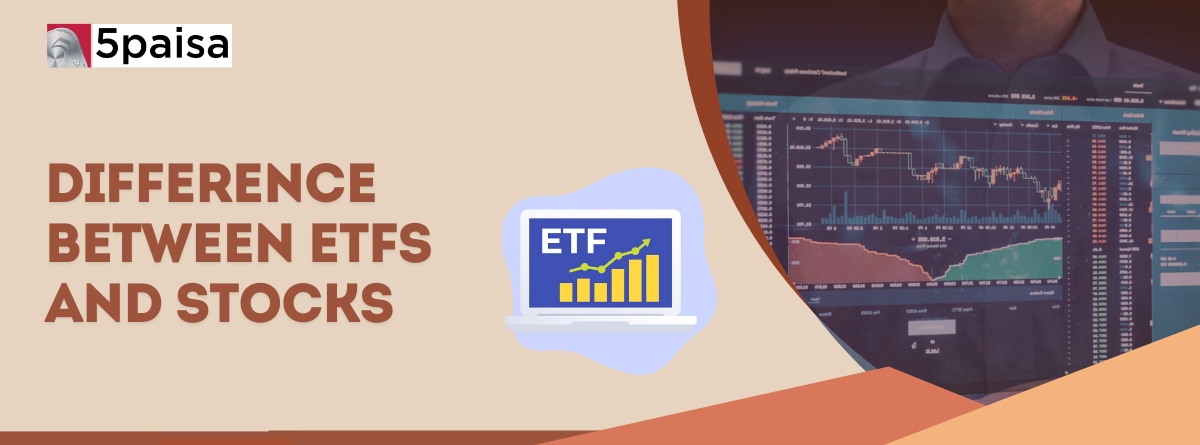Exchange-Traded Funds - ETFs and stocks are two important investment options for almost every investor. While they both provide potential for capital appreciation, they function quite differently. However, each has distinctive features that can make a big difference in your investing experience. So, what’s the difference, and which one’s right for you? Below is an analysis of each to guide your decision-making.
What are Stocks?
Purchasing a stock means gaining an ownership share in a listed company. The purchaser i.e. the stockholder becomes a partial owner of the listed company. So, if you buy shares of a firm (let's say tech firm TCS), your returns are dependent on the growth of that company. When the stock is increasing you make profits and similarly, if the stock is declining your returns will be negative as your returns will correlate with the company’s financial success. Although these stocks offer investors full control as well as the ability to curate a portfolio, they also carry substantial risk as each investment is dependent on the performance of a single entity.
What are ETFs?
Unlike stocks, an ETF or exchange traded fund is a pooled investment vehicle that aggregates various financial assets, such as bonds, stocks, and/or other securities, into one fund. By purchasing a unit of an ETF, investors gain exposure to a diversified set of assets. A type of mutual fund, they provide a structured way to diversify without investing in each component individually, mitigating some of the risk associated with single-stock exposure.
Comparative Analysis of ETFs and Stocks
Now that we have covered the basic meaning of both ETFs and stocks, let’s analyze them both
Diversification
Stocks: Investing in a stock means single-company exposure. This requires strategic research as well as analysis but limits diversification as the focus is on individual businesses.
ETFs: ETFs provide built-in diversification across sectors or indices, distributing risk across multiple companies and reducing dependence on individual stock performance.
Risk and Volatility
Stocks: Stocks often exhibit high volatility, with potential for substantial gains or losses. This makes them suitable for investors with high-risk tolerance.
ETFs: Due to their diversified nature, ETFs generally offer more stable performance, especially those tracking broad indices. They present a reduced volatility profile, especially in index-linked ETFs.
Cost Structure
Stocks: Stocks are typically subject to one-time transaction fees without ongoing management fees.
ETFs: ETFs incur annual fees, known as the expense ratio, which reflects fund management costs. Though these fees are generally low, they can impact returns over time.
Income Generation
Stocks: Many stocks offer dividends, providing investors with periodic income based on company profits.
ETFs: ETFs holding dividend-paying stocks can also yield dividends. Certain ETFs focus exclusively on dividend-paying assets, providing a more consistent income stream.
Management Style
Stocks: Stock investments provide investors with complete control over individual asset selection.
ETFs: ETFs are typically passively managed, tracking indices or sectors with minimal active involvement. Actively managed ETFs are also available but come with higher fees due to active decision-making by fund managers.

Which Is Better: Stocks or ETFs?
This depends on your investment goals. Ask yourself: Are you ready to research individual companies? If yes, stocks might suit you. Do you prefer simplicity and diversification? Then ETFs could be your go-to option.
Pros and Cons of Investing in Stocks
Pros:
- Higher Returns: Stocks have the potential to offer huge returns if chosen wisely.
- Direct Ownership: You feel connected to the company’s success.
- Voting Rights: Influence company decisions (for common stocks).
Cons:
- High Risk: If the company performs poorly, you lose money.
- Time-Consuming: Requires constant research and monitoring.
Pros and Cons of Investing in ETFs
Pros:
- Diversification: Reduce risk by spreading investments across various assets.
- Cost-Effective: Lower expense ratios compared to mutual funds.
- Easy to Trade: Similar to stocks, ETFs offer flexibility in trading.
Cons:
- Limited Growth: You won’t see explosive returns like you might with individual stocks.
- Management Fees: Though minimal, these still eat into your returns.
Decision-Making: Choosing Between ETFs and Stocks
For investors looking for diversified, lower-risk exposure, ETF is an efficient option. On the contrary, for investors who are interested in targeted, hands-on investing with higher risk and potential return, individual stocks offer greater control and customization. Many investors opt for a combination of both, utilizing ETFs as a foundation and selecting stocks to tailor their portfolios.




